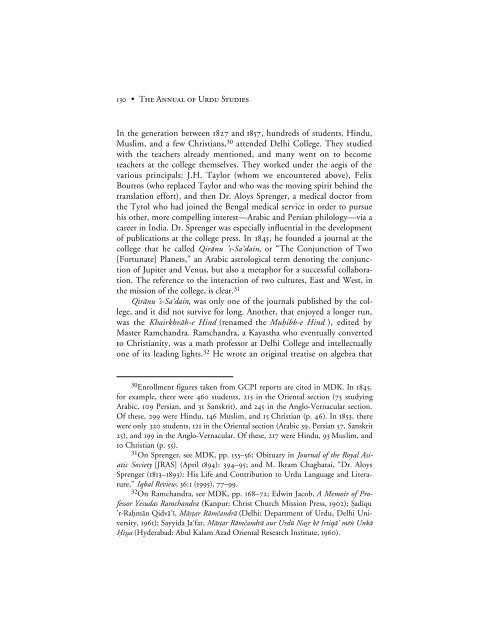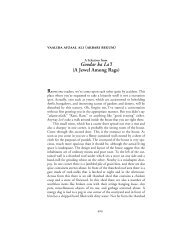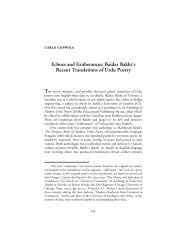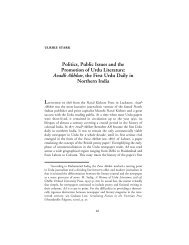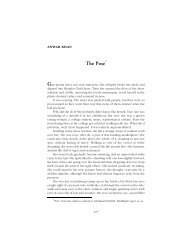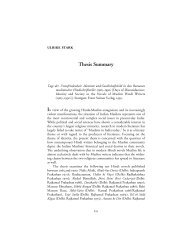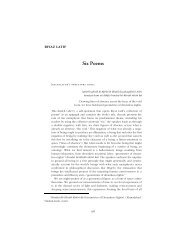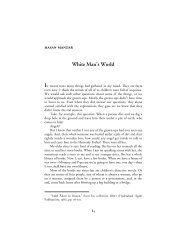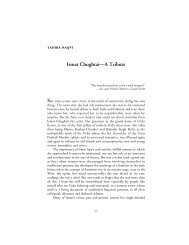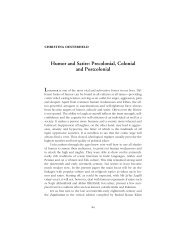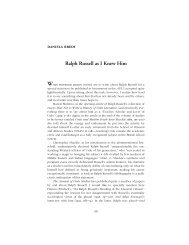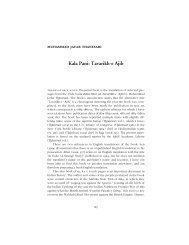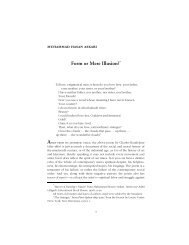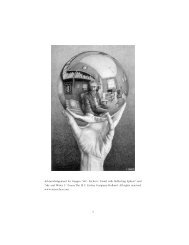Delhi College and Urdu* - MINDS@UW Home
Delhi College and Urdu* - MINDS@UW Home
Delhi College and Urdu* - MINDS@UW Home
Create successful ePaper yourself
Turn your PDF publications into a flip-book with our unique Google optimized e-Paper software.
130 • THE ANNUAL OF URDU STUDIESIn the generation between 1827 <strong>and</strong> 1857, hundreds of students, Hindu,Muslim, <strong>and</strong> a few Christians, 30 attended <strong>Delhi</strong> <strong>College</strong>. They studiedwith the teachers already mentioned, <strong>and</strong> many went on to becometeachers at the college themselves. They worked under the aegis of thevarious principals: J.H. Taylor (whom we encountered above), FelixBoutros (who replaced Taylor <strong>and</strong> who was the moving spirit behind thetranslation effort), <strong>and</strong> then Dr. Aloys Sprenger, a medical doctor fromthe Tyrol who had joined the Bengal medical service in order to pursuehis other, more compelling interest—Arabic <strong>and</strong> Persian philology—via acareer in India. Dr. Sprenger was especially influential in the developmentof publications at the college press. In 1845, he founded a journal at thecollege that he called Qir≥nu ’s-Sa‘dain, or “The Conjunction of Two[Fortunate] Planets,” an Arabic astrological term denoting the conjunctionof Jupiter <strong>and</strong> Venus, but also a metaphor for a successful collaboration.The reference to the interaction of two cultures, East <strong>and</strong> West, inthe mission of the college, is clear. 31Qir≥nu ’s-Sa‘dain, was only one of the journals published by the college,<strong>and</strong> it did not survive for long. Another, that enjoyed a longer run,was the Khairkhv≥h-e Hind (renamed the Mu√ibb-e Hind ), edited byMaster Ramch<strong>and</strong>ra. Ramch<strong>and</strong>ra, a Kayastha who eventually convertedto Christianity, was a math professor at <strong>Delhi</strong> <strong>College</strong> <strong>and</strong> intellectuallyone of its leading lights. 32 He wrote an original treatise on algebra that30 Enrollment figures taken from GCPI reports are cited in MDK. In 1845,for example, there were 460 students, 215 in the Oriental section (75 studyingArabic, 109 Persian, <strong>and</strong> 31 Sanskrit), <strong>and</strong> 245 in the Anglo-Vernacular section.Of these, 299 were Hindu, 146 Muslim, <strong>and</strong> 15 Christian (p. 46). In 1853, therewere only 320 students, 121 in the Oriental section (Arabic 39, Persian 57, Sanskrit25), <strong>and</strong> 199 in the Anglo-Vernacular. Of these, 217 were Hindu, 93 Muslim, <strong>and</strong>10 Christian (p. 55).31 On Sprenger, see MDK, pp. 155–56; Obituary in Journal of the Royal AsiaticSociety [JRAS] (April 1894): 394–95; <strong>and</strong> M. Ikram Chaghatai, “Dr. AloysSprenger (1813–1893): His Life <strong>and</strong> Contribution to Urdu Language <strong>and</strong> Literature,”Iqbal Review, 36:1 (1995), 77–99.32 On Ramch<strong>and</strong>ra, see MDK, pp. 168–72; Edwin Jacob, A Memoir of ProfessorYesudas Ramch<strong>and</strong>ra (Kanpur: Christ Church Mission Press, 1902); ¿adµqu’r-Ra√m≥n Qidv≥’µ, M≥sªar R≥m±<strong>and</strong>r≥ (<strong>Delhi</strong>: Department of Urdu, <strong>Delhi</strong> University,1961); Sayyida Ja‘far, M≥sªar R≥m±<strong>and</strong>r≥ aur Urd∑ Na¡r k® Irtiq≥’ m® Unk≥ƒiΩΩa (Hyderabad: Abul Kalam Azad Oriental Research Institute, 1960).


